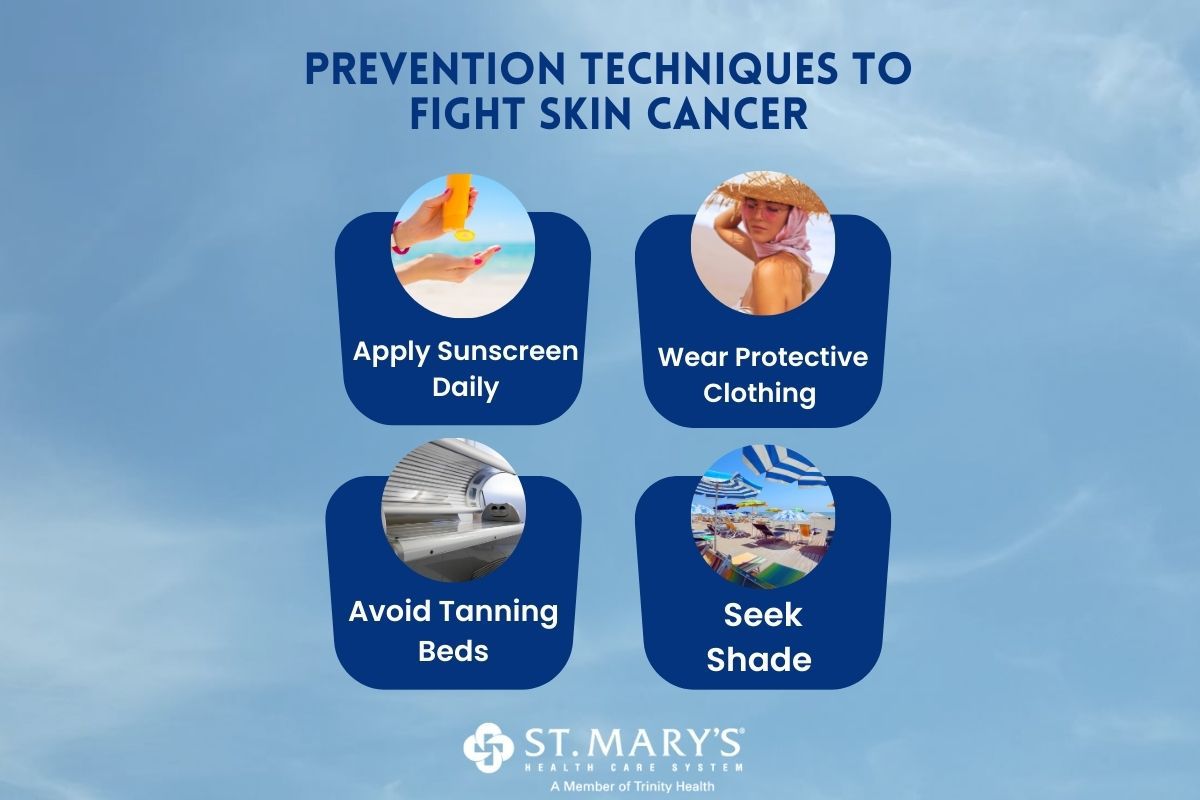6 Ways to Avoid Skin Cancer
July 23, 2023The most seen types of skin cancer are basal and squamous cell carcinomas.
Skin cancer is the most common cancer in the United States. Most skin cancers are caused by excess exposure to ultraviolet (UV) rays. However, you can lower your risk of developing skin cancer by incorporating various sun safety techniques into your life. The CDC, American Academy of Dermatology Association and Mayo Clinic outline some important information regarding skin cancer information and prevention.
What is skin cancer?
First, to prevent the risk of skin cancer, it is important to understand what it is. Skin cancer is the abnormal growth of skin cells. The most seen types of skin cancer are basal and squamous cell carcinomas.
What are skin cancer risk factors?
Skin cancer has several causes, consisting of both modifiable and nonmodifiable risk factors. Modifiable risk factors that can lead to skin cancer include excess exposure to the sun’s harsh ultraviolet (UV) rays, use of tanning beds, and sunburning due to lack of sun protection. Non-modifiable risk factors include family history, fair skin that burns or freckles easily, older age, and light-colored eyes.
What are the signs and symptoms of skin cancer?
Changes in skin appearance and feeling is one of the most common indicators of skin cancer development. Changes in skin can include but are not limited to developing sores or lesions, abnormally shaped moles or spots, or waxy and pearly bumps. Left untreated, skin cancers can grow, and cancerous cells can spread to other parts of the body. Treatment is most effective when the cancer is detected early.
What are some helpful tips and habits to avoid skin cancer?
The risk of developing skin cancer depends on a multitude of factors; however, there are some habits that can be implemented in your life that are known to reduce your risk.
1. Apply Sunscreen Daily
Topical sunscreen lotions or sprays help prevent UV light from reaching your skin by absorbing or reflecting the harmful rays. Be sure the sunscreen you use blocks both UVA and UVB rays. Follow label directions for how much to use and when to re-apply.
2. Use Sunglasses
While they don’t prevent skin cancer, sunglasses can also be a helpful sun protection tool. Sunglasses greatly reduce your eyes' exposure to harmful UV rays and can reduce your risk of cataracts and other serious eye conditions. Sunglasses that block both UVA and UVB rays are highly recommended by the CDC.
3. Avoid Tanning Beds
Tanning beds intentionally expose your body to excess levels of UV rays. Consistent use of tanning beds over time will cause damage and heighten your risk of skin cancer.
4. Wear Protective Clothing
If you know you are going to be outside for a long period of time for work or leisure, consider adding sleeves or wide-brimmed hats to your outfit. Covering areas of skin that would otherwise face overexposure can be helpful in preventing sun damage that could later contribute to skin cancer development.
5. Don’t be afraid to seek shade
Seeking shade is a great way to enjoy being outside while reducing your body's risk of harmful UV exposure. Going to the beach? Bring an umbrella! Going for a walk? Look into shady, tree-covered trails!
6. Avoid the midday sun
UV radiation is most intense during the middle of the day when the sun is most intense and most directly overhead. You can reduce your UV exposure by moving your outdoor activities to early in the morning or late in the afternoon or evening when sunlight is less direct and there is more shade.
With skin cancer being the most common cancer type, it is important to take action to help protect your body and prevent skin cancer from developing. Enacting some of these healthy habits and increasing UV awareness is a great start to decreasing your risk of skin cancer in the future.
Did you know your primary care physician can check for signs of skin cancer? If you have a spot that you are concerned about – or if you would like to include a skin check in your annual wellness visit – call your PCP’s office today.

